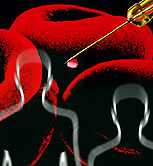
WEDNESDAY, Feb. 27 (HealthDay News) — Researchers say they’ve found a way to tweak and strengthen immune cells to maximize their leukemia-fighting capability while minimizing their toxic effects on the patient.
The chemotherapy that leukemia patients typically receive to kill cancer cells can also destroy the body’s ability to produce new blood cells, the U.S. researchers explained.
And while bone marrow transplants can restore the body’s ability to produce blood cells, that procedure is also a double-edged sword: If the donor is not perfectly matched, the new donor cells can attack the patient, resulting in potentially life-threatening graft-versus-host disease.
Given the limitations of these two standard treatments, “researchers have long sought ways to maximize the anti-leukemic response in these [bone marrow] transplants while minimizing the risk to host tissues,” explained David Wiest, deputy science director at Fox Chase Cancer Center in Philadelphia.
The new research takes an important step towards that goal, said Wiest, who was not involved with the study.
In the study, published Feb. 27 in Science Translational Medicine, the researchers supplemented bone marrow transplant with an additional population of T lymphocytes — immune “T cells” from the same donors. These cells were “educated” in the lab to recognize a specific target, a protein called Wilms Tumor Antigen (WT1), explained study lead author Dr. Aude Chapuis.
“WT1 is an ideal target because it is not only highly expressed [produced] in the leukemia cells but is also required for their survival,” Wiest explained. “So, the leukemias cannot afford to shrug off this molecule to escape the deadly attack by these T cells.”
While voracious in their appetite for cancer-linked WT1, these modified immune cells left the patients’ healthy cells alone, which is what the researchers wanted.
But despite their careful cultivation, the transferred T cells were initially not as effective as the researchers had hoped. Although some benefit was seen, it was short-lived.
The researchers then found that exposing the T cells to interleukin-21 (IL-21), an immune-system molecule, made the cell more resilient and long-lasting without changing what they were trained to recognize, explained study senior author Dr. Philip Greenberg, head of the Program in Immunology at Fred Hutchinson Cancer Research Center and professor of medicine and immunology at the University of Washington in Seattle.
Four leukemia patients were treated with these T cells that were both trained to go after WT1 and were pretreated with IL-21. All four have now been in remission for two or more years since the T-cell therapy was completed, and none have suffered graft-versus-host disease, the researchers reported.
One of these patients was in relapse at the time of the infusion and is now in remission. The other three patients had no detectable disease at the time of the infusion but, given the characteristics of their disease, would have been expected to relapse two to five months after the therapy, Greenberg said.
“T cells produced in this manner not only exhibited greater persistence upon transfer into the patients, but were also far more effective in killing the leukemia cells,” said Wiest. “The ramped-up T cells not only fought off the leukemia but did so over a sustained period of time.”
The researchers believe the protocol could not only treat different types of leukemia but perhaps also other cancers in general.
“Because WT1 is not only expressed in leukemia but broadly across tumors, the goal is to use [these types of cells] to treat other cancers,” said Chapuis, who is a research associate at Fred Hutchinson Cancer Research Center and acting instructor at the University of Washington Medical Center in Seattle.
Greenberg added, “This is telling us that we can create an immunotherapy that recognizes a protein [WT1] that’s associated with why a cell is cancerous. This really is opening up a very large window of immunotherapies targeting these cancer-associated proteins . . . [We can] start using immune cells to ferret out cells overexpressing that protein and use that as their Achilles’ heel.”
The study was also significant in that the researchers were able to guide these cells to recognize a specific target and reproduce them in the billions outside of the body, said Dr. Ryotaro Nakamura, associate professor of hematology and hematopoietic stem cell transplantation at City of Hope in Duarte, Calif.
It’s unclear how the results will apply in a larger population, but the technique used was “remarkable,” Nakamura said.
More information
There’s more on leukemia at the U.S. National Cancer Institute.

